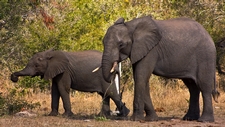Parents and Offspring

TEKS Objective
Demonstrate that some likenesses between parents and offspring are inherited, passed from generation to generation such as eye color in humans or shapes of leaves in plants. Other likenesses are learned such as table manners or reading a books and seals balancing balls on their noses.
Essential Understanding
The student knows that organisms undergo similar life processes and have structures that help them survive within their environment.
Science Background
The Genetics of Inherited Traits: BioEd Online (video) – Dr. Ron McNeel explains how genetic information is passed from one generation to the next during this 20-minute video segment.
The Genetics of Inherited Traits
BioEd Online, www.bioedonline.org
DNA From the Beginning: Cold Spring Harbor Laboratory (website) - Begin with “Classical Genetics,” and continue to “Molecules of Genetics” and “Genetic Organization and Control” for a detailed overview of how genetic characteristics are passed from one generation to the next, among other related topics. Includes extensive background information, video, interactive questions to test knowledge, and links to other resources.
DNA From the Beginning
Cold Spring Harbor Laboratory, www.dnaftb.org
What Is Heredity? Genetic Science Learning Center (website) - A slideshow/tutorial that explains how traits are passed from parents to offspring.
What is Heredity?
Genetic Science Learning Center, learn.genetics.utah.edu
Signature Lesson
Reebops - A model organism for teaching genetics concepts: BioEd Online (website) – In this updated version of a classic life sciences activity, students create imaginary creatures to demonstrate how hereditary information is passed from one generation to the next.
Reebops: A model organism for teaching genetics concepts
BioEd Online, www.bioedonline.org
- Supporting Lessons
- Extensions
- Assessment Ideas
- Literature Connections
- Related
TEKS - Additional Resources
Supporting Lessons
Family Traits Trivia: Genetic Science Learning Center (PDF) - In this take-home game/activity, students conduct inherited traits surveys of their families. In class, students chart and discuss their data and write descriptions of their discoveries to understand that 1) every person has a combination of traits that is unique to him or her, 2) some traits are inherited, and 3) other traits may be learned.
Family Traits Trivia
Genetics Science Learning Center, www.teach.genetics.utah.edu
Genetics for Kids Mini-lecture and Punnett’s Square Activity: Exploring Nature Educational Resource (website) - A brief overview of genetics and traits, followed by a simple Punnett’s Square activity for pea plants.
Traits Bingo: Genetic Science Learning Center (PDF) - Genetics review activity in which students play a game of bingo focused on questions about their genetic traits. Includes a Spanish language version. (Might this also work as an assessment?)
Traits Bingo
Genetic Science Learning Center, www.teach.genetics.utah.edu
Elaboration Lessons and Extensions
Generations of Traits: Genetic Science Learning Center (PDF) - Hands-on activity during which students track and record the passage of colored “traits” through three generations of gingerbread “people,” thereby learning that that traits are passed from parents to offspring, and that siblings may or may not receive the same traits from their parents.
Generations of Traits
Genetic Science Learning Center, www.teach.genetics.utah.edu
Assessment Ideas
Ask the class, Do you resemble your brothers, sisters or cousins? Have students list the most notable traits of their brothers, sisters or close cousins, and then organize this information on a chart.
Have each student write an essay describing any resemblances between him/herself and his/her brothers, sisters and cousins, and providing a possible explanation for these similarities.
Literature Connections
Blame Your Parents: Inherited Traits. Silverman, Buffy (ISBN-13: 978-1410928580)
Animals and Their Young: How Animals Produce and Care for Their Babies. Hickman, Pamela (ISBN-13: 978-1553370628)
How Animals Care for their Babies. National Geographic (ISBN-13: 978-0792234074)
Who Grows Up in the Desert? Longenecker, Theresa (ISBN-13: 978-1404802063)
Who Grows Up in the Forest? Longenecker, Theresa (ISBN-13: 978-1404802070)
Who Grows Up in the Farm? Longenecker, Theresa (ISBN-13: 978-1404800298)
Who Grows Up in the Ocean? Longenecker, Theresa (ISBN-13: 978-1404802087)
Who Grows Up in the Snow? Longenecker, Theresa (ISBN-13: 978-1404802100)
Who Grows Up in the Rain Forest? Longenecker, Theresa (ISBN-13: 978-1404800274)
Additional Resources
An Introduction to Genes and Inherited Traits: BioEd Online (online course) – Develop your own knowledge and earn contact hour credit by taking this short online course. (Scroll down the page until you reach the course entitled: An Introduction to Genes and Inherited Traits.)
An Introduction to Genes and Inherited Traits
BioEd Online, www.bioedonline.org
TEKS Navigation
Grade 4
Need Assistance?
If you need help or have a question please use the links below to help resolve your problem.

Comments